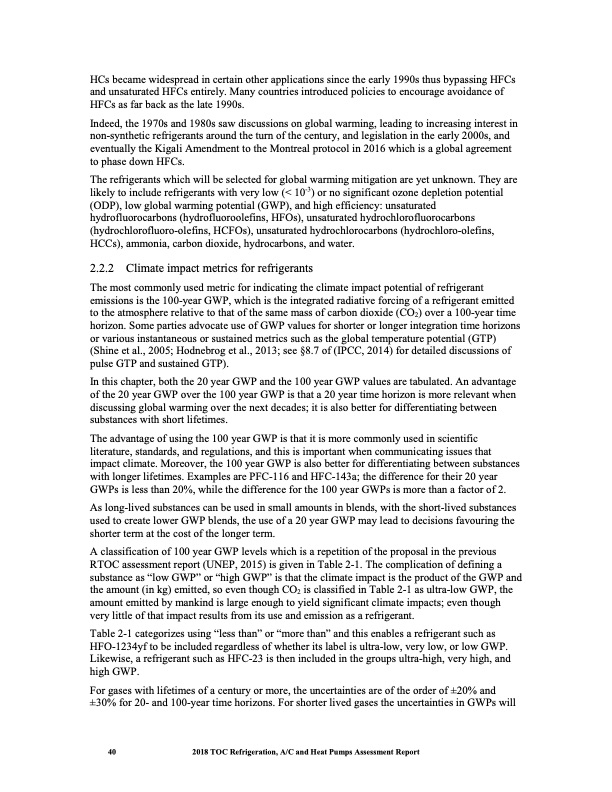
PDF Publication Title:
Text from PDF Page: 053
HCs became widespread in certain other applications since the early 1990s thus bypassing HFCs and unsaturated HFCs entirely. Many countries introduced policies to encourage avoidance of HFCs as far back as the late 1990s. Indeed, the 1970s and 1980s saw discussions on global warming, leading to increasing interest in non-synthetic refrigerants around the turn of the century, and legislation in the early 2000s, and eventually the Kigali Amendment to the Montreal protocol in 2016 which is a global agreement to phase down HFCs. The refrigerants which will be selected for global warming mitigation are yet unknown. They are likely to include refrigerants with very low (< 10-3) or no significant ozone depletion potential (ODP), low global warming potential (GWP), and high efficiency: unsaturated hydrofluorocarbons (hydrofluoroolefins, HFOs), unsaturated hydrochlorofluorocarbons (hydrochlorofluoro-olefins, HCFOs), unsaturated hydrochlorocarbons (hydrochloro-olefins, HCCs), ammonia, carbon dioxide, hydrocarbons, and water. 2.2.2 Climate impact metrics for refrigerants The most commonly used metric for indicating the climate impact potential of refrigerant emissions is the 100-year GWP, which is the integrated radiative forcing of a refrigerant emitted to the atmosphere relative to that of the same mass of carbon dioxide (CO2) over a 100-year time horizon. Some parties advocate use of GWP values for shorter or longer integration time horizons or various instantaneous or sustained metrics such as the global temperature potential (GTP) (Shine et al., 2005; Hodnebrog et al., 2013; see §8.7 of (IPCC, 2014) for detailed discussions of pulse GTP and sustained GTP). In this chapter, both the 20 year GWP and the 100 year GWP values are tabulated. An advantage of the 20 year GWP over the 100 year GWP is that a 20 year time horizon is more relevant when discussing global warming over the next decades; it is also better for differentiating between substances with short lifetimes. The advantage of using the 100 year GWP is that it is more commonly used in scientific literature, standards, and regulations, and this is important when communicating issues that impact climate. Moreover, the 100 year GWP is also better for differentiating between substances with longer lifetimes. Examples are PFC-116 and HFC-143a; the difference for their 20 year GWPs is less than 20%, while the difference for the 100 year GWPs is more than a factor of 2. As long-lived substances can be used in small amounts in blends, with the short-lived substances used to create lower GWP blends, the use of a 20 year GWP may lead to decisions favouring the shorter term at the cost of the longer term. A classification of 100 year GWP levels which is a repetition of the proposal in the previous RTOC assessment report (UNEP, 2015) is given in Table 2-1. The complication of defining a substance as “low GWP” or “high GWP” is that the climate impact is the product of the GWP and the amount (in kg) emitted, so even though CO2 is classified in Table 2-1 as ultra-low GWP, the amount emitted by mankind is large enough to yield significant climate impacts; even though very little of that impact results from its use and emission as a refrigerant. Table 2-1 categorizes using “less than” or “more than” and this enables a refrigerant such as HFO-1234yf to be included regardless of whether its label is ultra-low, very low, or low GWP. Likewise, a refrigerant such as HFC-23 is then included in the groups ultra-high, very high, and high GWP. For gases with lifetimes of a century or more, the uncertainties are of the order of ±20% and ±30% for 20- and 100-year time horizons. For shorter lived gases the uncertainties in GWPs will 40 2018 TOC Refrigeration, A/C and Heat Pumps Assessment ReportPDF Image | Heat Pumps Technical Options

PDF Search Title:
Heat Pumps Technical OptionsOriginal File Name Searched:
RTOC-assessment-report-2018_0.pdfDIY PDF Search: Google It | Yahoo | Bing
CO2 Organic Rankine Cycle Experimenter Platform The supercritical CO2 phase change system is both a heat pump and organic rankine cycle which can be used for those purposes and as a supercritical extractor for advanced subcritical and supercritical extraction technology. Uses include producing nanoparticles, precious metal CO2 extraction, lithium battery recycling, and other applications... More Info
Heat Pumps CO2 ORC Heat Pump System Platform More Info
| CONTACT TEL: 608-238-6001 Email: greg@infinityturbine.com | RSS | AMP |